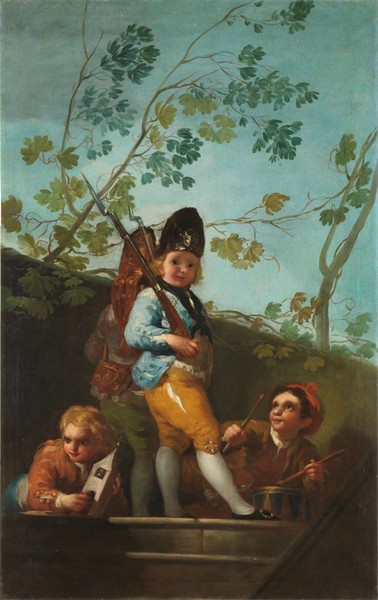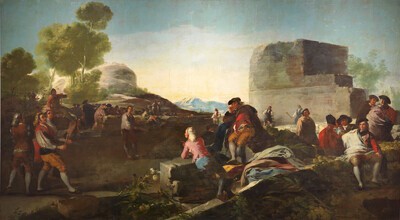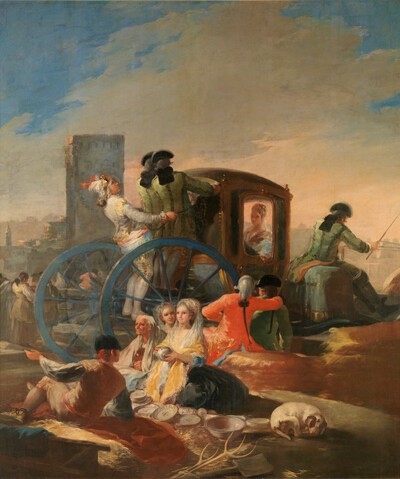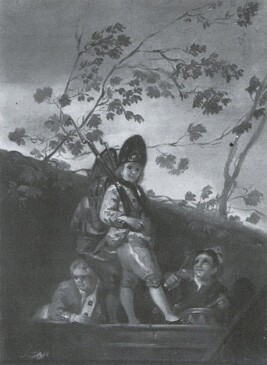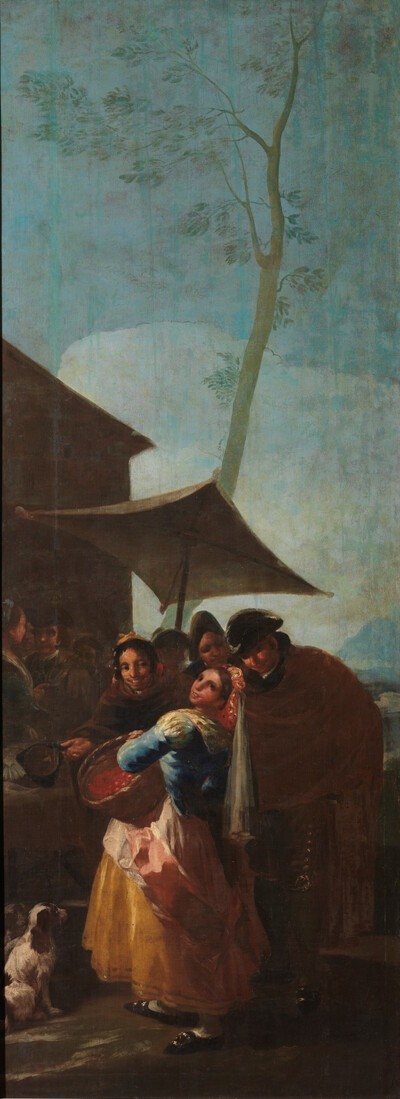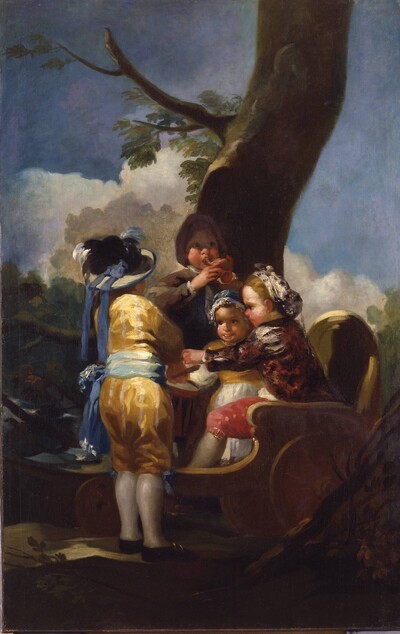- Cronología
- 1778 - 1780
- Ubicación
- The Prado National Museum. Madrid, Madrid, Spain
- Dimensiones
- 146 x 94 cm
- Técnica y soporte
- Oil on canvas
- Reconocimiento de la autoría de Goya
- Documented work
- Titular
- El Prado National Museum
- Ficha: realización/revisión
- 23 Nov 2009 / 14 Jun 2023
- Inventario
- (P00783)
- Otros títulos:
-
Children Playing at Soldiers (Niños jugando a soldados)
See The Fair at Madrid.
The tapestry resulting from this cartoon was made to be hung over a door, on the west wall of the bedroom, facing its companion piece, Children with a Cart.
Four children play at being soldiers, with rifles, a drum and a miniature church tower from the fair.
Children are a recurrent theme in Goya's work, and this was not the first time that he used them in decorative overdoor pieces - he did the same in the dining room of the palace of El Pardo, where the children were used to counterbalance the adult figures. Here, the children's games, so loaded with fantasy, can, according to Tomlinson, be tied to the fleeting nature of childish revelry and the madness of the adult spectacle represented in the neighbouring scenes.
By painting children in works designed to be hung above doors and windows, the artist did not need to drastically reduce the size of the figures, and the series maintained a more coherent appearance.
The reddish preparation that Goya applied, sometimes covered with a thin glaze, has caused the work to darken over the years. Its colours now appear flat and lack the tonal range that they would have had originally.
-
GoyaPalacio de PedralbesBarcelona1977from April 12th to June 30th 1977cat. 7
-
GoyaNationalmuseumStockholm1994consultant editors Juan J. Luna and Görel Cavalli-Björkman. From October 7th 1994 to January 8th 1995cat. 4
-
Goya. 250 AniversarioMuseo Nacional del PradoMadrid1996consultant editor Juan J. Luna. From March 29th to June 2nd 1996cat. 22
-
Goya en Madrid. Cartones para tapices 1775-1794Museo Nacional del PradoMadrid2014p. 197
-
Tapices de GoyaMadridPatrimonio Nacional1946pp. 111, 226, cat. 25 y láms. 108-109
-
L'œuvre peint de Goya. 4 volsParís1928-1950vol. I, p. 75, cat. 16
-
Vie et ouvre de Francisco de GoyaParísOffice du livre1970pp. 76, 88, cat. 128
-
BarcelonaPolígrafa1970vol. I, pp. 247-248, cat. 79
-
L’opera pittorica completa di GoyaMilanRizzoli1974p. 95, cat. 85
-
Francisco de Goya, 4 vols.ZaragozaCaja de Ahorros de Zaragoza, Aragón y Rioja1980-1982vol. I, p. 98 y p. 152 (il.)
-
Francisco de Goya, cartones y tapicescol. col. "Espasa Arte"Espasa Calpe1987pp. 93, 101, 268, cat. 29C
-
Francisco de Goya. Los cartones para tapices y los comienzos de su carrera en la corte de Madridcol. col. "Ensayos de Arte Cátedra"MadridCátedra1987pp. 118, 119 y p. 117 (il.)
-
Goya. 250 AniversarioMadridMuseo del Prado1996pp. 302-303, cat. 22
-
Salas del Palacio Real de El Pardo para las que se tejieron tapices sobre cartones de Francisco de Goya: identificación de las habitaciones y ajuste de las obras de Goya en los alzados de las paredesin HERRERO CARRETERO, Concha (curator, Tapices y cartones de Goya (catalogue of the exhibition organizated at the Palacio Real de Madrid, from may to june 1996)MadridPatrimonio Nacional, Goya 96, Lunwerg1996p. 170 (il.)
-
Cartas a Martín ZapaterMadridIstmo2003p. 72, nº 8
-
Goya en Madrid. Cartones para tapices 1775-1794MadridMuseo Nacional del Prado2014p. 197
